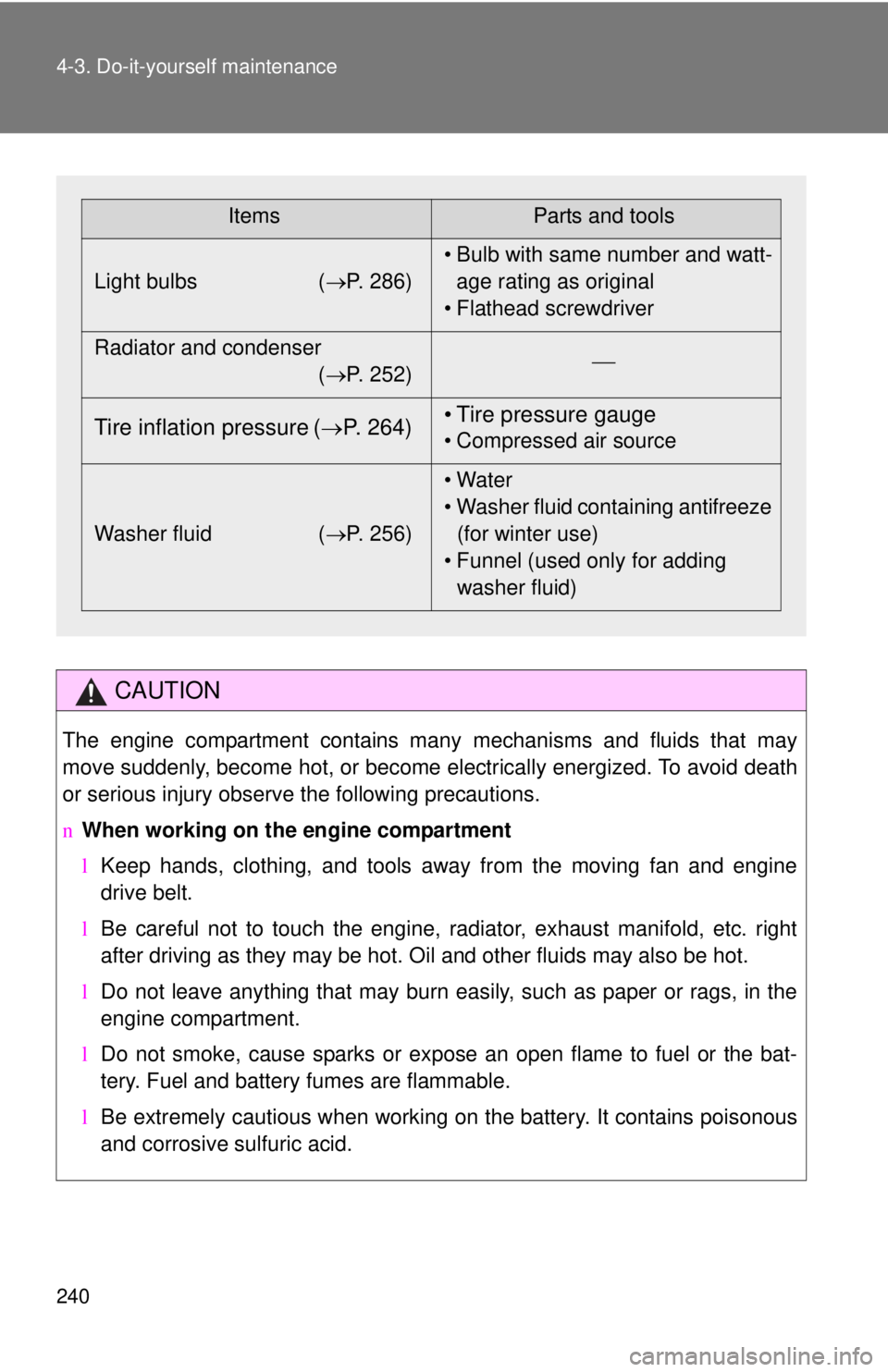Page 18 of 402
16
SAFETY AND
EMERGENCY FEATURES
Keep as low on
hips as possible
Take up slack
To o h i g h
Seatbelts
If belt is fully extended, then retracted even slightly, it cannot be
re-extended beyond that point, unless fully retracted again. This feature
is used to help hold child restraint systems securely.
To find more information about seatbelts, and how to install a child
restraint system, refer to theOwner’s Manual.
Door locks-Power (if equipped)
UnlockLock
If tire pressure becomes critically low on any of the tires (excluding the
spare), indicator will illuminate. Correctly adjusting tire inflation will
turn off the light after a few minutes. If the light does not turn off, have
the system checked by your Toyota dealer.
RefertotheOwner’s Manual for more details.
Tire Pressure Monitoring (warning)
System
412782M2.qxd:_412782M2 8/18/08 2:08 PM Page 16
Page 27 of 402
7
Tires
lRotation
l Replacement
l Inflation pressure
l Information
P. 258
P. 317
P. 264
P. 356
∗: If equipped
Back door P. 36Side doors P. 31
Fuel filler door P. 70
Rear turn signal lights P. 131
Rear window defogger∗ P. 185
License plate light P. 145
Stop/tail and rear side
marker lights
P. 145
Rear window wiper∗ P. 151
Page 29 of 402
9
Tires
lRotation
l Replacement
l Inflation pressure
l Information
P. 258
P. 317
P. 264
P. 356
∗: If equipped
Back door P. 36Side doors P. 31
Fuel filler door P. 70
Rear turn signal lights P. 131
Rear window defogger∗ P. 185
License plate light P. 145
Stop/tail and rear side
marker lights
P. 145
Rear window wiper∗ P. 151
Page 248 of 402
237
4-2. Maintenance
4
Maintenance and care
Vehicle exterior
Steering wheel
• Moves smoothly?
• Has correct free play?
• No strange noises?
ItemsCheck points
Doors • Operate smoothly?
Engine hood • The lock system works properly?
Fluid leaks • Is there any leakage after park-
ing?
Tire • Inflation pressure is correct?
• Tire surfaces not worn or dam-
aged?
• Tires rotated according to the maintenance schedule?
• Wheel nuts are not loose?
CAUTION
n If the engine is running
Turn the engine off and ensure that there is adequate ventilation before per-
forming maintenance checks.
ItemsCheck points
Page 251 of 402

240 4-3. Do-it-yourself maintenance
CAUTION
The engine compartment contains many mechanisms and fluids that may
move suddenly, become hot, or become electrically energized. To avoid death
or serious injury observe the following precautions.
nWhen working on the engine compartment
lKeep hands, clothing, and tools away from the moving fan and engine
drive belt.
l Be careful not to touch the engine, radiator, exhaust manifold, etc. right
after driving as they may be hot. Oil and other fluids may also be hot.
l Do not leave anything that may burn easily, such as paper or rags, in the
engine compartment.
l Do not smoke, cause sparks or expose an open flame to fuel or the bat-
tery. Fuel and battery fumes are flammable.
l Be extremely cautious when working on the battery. It contains poisonous
and corrosive sulfuric acid.
ItemsParts and tools
Light bulbs ( →P. 286)• Bulb with same number and watt-
age rating as original
• Flathead screwdriver
Radiator and condenser
( →P. 252) ⎯
Tire inflation pressure (
→P. 264) • Tire pressure gauge• Compressed air source
Washer fluid ( →P. 256)• Water
• Washer fluid containing antifreeze
(for winter use)
• Funnel (used only for adding washer fluid)
Page 269 of 402
258
4-3. Do-it-yourself maintenance
Tires
Replace or rotate tires in accordance with maintenance sched-
ules and treadwear.
n Checking tires
New tread
Treadwear indicator
Worn tread
The location of treadwear
indicators is shown by the
“TWI” or “” marks, etc.,
molded on the sidewall of
ea
ch tire.
Check spare tire condition
an
d inflation pressure if not
rotated.
n Tire rotation
Rotate the tires in the order
show
n.
To equalize tire wear and
extend tire life, Toyota recom -
mends that tire rotation is
ca
rried out at the same inter -
val as tire inspection.
n The tire pressure warning system
Your Toyota is equipped with a tire pressure warning system that
use
s tire pressure warning valves and transmitters to detect low
tire inflation pressure before serious problems arise. (→P. 310 )
Front
Page 271 of 402

260 4-3. Do-it-yourself maintenance
nIf the tread wears down below 0.16 in. (4 mm) on snow tires
The effectiveness of snow tires is lost.
nMaximum load of tire
Check that the maximum load of the replaced tire is greater than 1/2 of
the Gross Axle Weight Ratings (GAWR) of either the front axle or the
rear axle, whichever is greater.
As for the maximum load of the tire, see the load limit at maximum cold
tire inflation pressure mentioned on the sidewall of the tire, and as for the
Gross Axle Weight Ratings (GAWR) , see the Certification Label. (→P.
264, 356).
nTire types
1 Summer tires
Summer tires are high-speed performance tires best suited to highway
driving under dry conditions. Since summer tires do not have the same
traction performance as snow tire s, summer tires are inadequate for
driving on snow-covered or icy roads. For driving on snow-covered
roads or icy roads, the use of snow tires is recommended. When
installing snow tires, be sure to replace all four tires.
2 All season tires
All season tires are designed to provide better traction in snow and to
be adequate for driving in most winter conditions, as well as for use
year round. All season tires, however, do not have adequate traction
performance compared with snow tires in heavy or loose snow. Also,
all season tires fall short in acceleration and handling performance
compared with summer tires in highway driving.
3Snow tires For driving on snow-covered roads or icy roads, we recommend using
snow tires. If you need snow tires, select tires of the same size, con-
struction and load capacity as the or iginally installed tires. Since your
vehicle has radial tires as original equipment, make sure your snow
tires also have radial construction. Do not install studded tires without
first checking local regulations for possible restriction. Snow tires
should be installed on all wheels. ( →P. 161)
Page 272 of 402
261
4-3. Do-it-yourself maintenance
4
Maintenance and care
nRoutine tire inflation pressure checks
The tire pressure warning system doe
s not replace routine tire inflation
pressure checks. Ma ke sure to check tire infl ation pressure as part of
your routine of daily vehicle checks.
nTire pressure warning system certification
MODEL/FCC IDs:
Transmitter: PAXPMV107J
Receiver: HYQ13BCX
For vehicles sold in U.S.A.
NOTE:
This device complies with Part 15 of the FCC Rules. Operation is subject
to the following two conditions: (1) This device may not cause harmful
interference, and (2) this device must accept any interference received,
including interference that may cause undesired operation.
FCC WARNING:
Changes or modifications not expre ssly approved by the party responsi-
ble for compliance could void the user's authority to operate the equip-
ment.